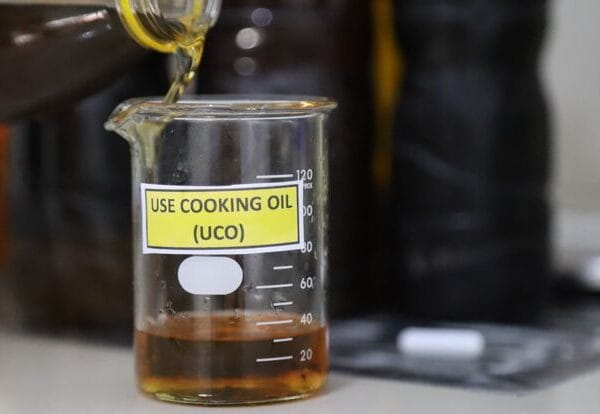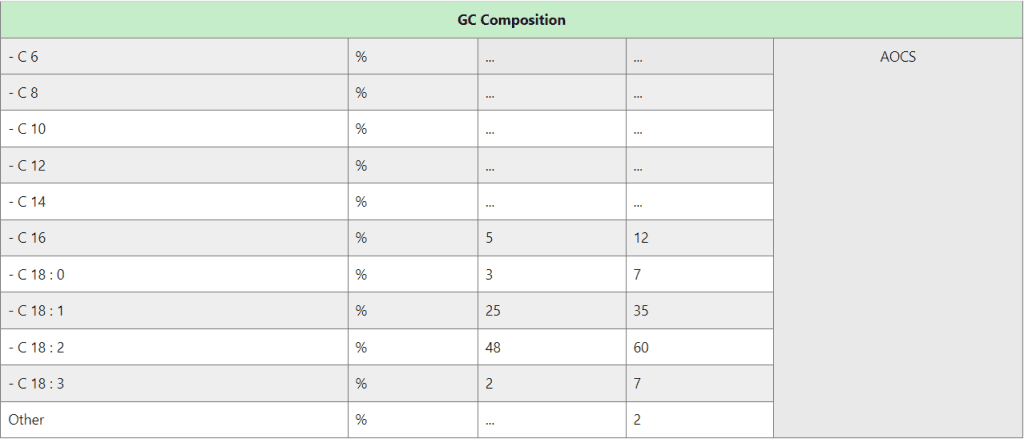
Used cooking oil (UCO)
1. Biofuel Industry
Used cooking oil, a very valuable feedstock for the synthesis of biodiesel, is essentially made up of fats and oils gathered after cooking or frying processes. Although considered a waste material, used cooking oil can effectively be converted into biofuel by means of processes such as transesterification, whereby the oils and fats are transformed into fatty acid methyl esters (FAME), resulting in the production of biodiesel.
Advantages:
Sustainability: The use of UCO to produce biodiesel encourages the circular economy and prevents environmental pollution by the reuse of waste oil that would have been disposed of.
Economically Efficient: UCO represents a cost-effective alternative to virgin vegetable oils, thus improving the economic feasibility of biodiesel production.
Renewable Resource: Biodiesel from UCO can be considered a renewable source of fuel to reduce greenhouse gas emissions and dependence on fossil fuels.
Compatibility: Biodiesel produced from UCO can be blended with conventional diesel or used directly in diesel engines, offering a cleaner-burning fuel option with lower sulfur emissions and an improved carbon footprint.
2. Animal Feed Industry
It is incorporated into the food for animals, used generally as an energy supplement in feed for ruminants like cattle. In this sector, UCO goes through cleaning, filtering, and sometimes treatment processes to ensure it is safe and suitable for use in animal consumption.
Advantages:
High Energy Content: UCO provides a good source of fats, thereby providing an energy-dense material to promote fast weight gain and high feed efficiency in animals, mainly within cattle and poultry. Savings in cost: UCO use in feed saves on feeding costs as it is lower priced compared to other sources of fats and oils. Improved Feed Palatability: The addition of UCO may improve the palatability of animal feed, thus promoting increased feed intake by animals. Fat supplementation with UCO is an easy way to increase the fat levels of animals’ diets, which improves the absorption of fat-soluble vitamins—like A, D, E, and K—and allows better health and productivity outcomes.
Used Cooking Oil : Chemical Constituents in Used Cooking Oil
Used Cooking Oil generally consists of triglycerides, free fatty acids (FFAs), and trace impurities, which can include food particles, oxidation products, and trace amounts of water. The exact composition may change depending on the type of oil and its application. Key parameters that influence UCO properties are:
Triglycerides: The main fat molecules in UCO, consisting of glycerol joined to three chains of fatty acids. These are the major feedstock for the production of biofuels.
Free fatty acids (FFAs) tend to rise as oil undergoes frying processes, due to hydrolysis and thermal degradation, in consequence affecting stability and quality of the oil. The increased concentration of FFAs can make UCO more suitable for some applications, such as biodiesel production. Industrial lubricants and biolubricants
Technical Details:
Biolubricant Base: UCO can be refined and chemically modified to produce biolubricants. These green lubricants are biodegradable and used in industrial machinery to reduce the environmental impact in case of spills.
It is noted that blending and the use of additives may enhance the performance characteristics of UCO-based biolubricants in applications, including viscosity, oxidative stability, and thermal resistance.
Applications in lubricants:
Hydraulic Fluids and Greases: UCO is used in hydraulic fluids, industrial greases, and cutting fluids—offering a renewable alternative to petroleum-based products. Eco-Friendly Industrial Applications: UCO biolubricants are specially appreciated in environmentally sensitive areas such as agriculture and forestry, where biodegradability is a strict advantage.
Benefits of Using Recycled Cooking Oil Cost Efficiency: Since UCO is cheaper than virgin oils, it presents a cost-effective feedstock for biofuel, animal feed, and the soap industry.
- CAS #: 112-80-1
- SYNONYM: (9Z)-Octadec-9-enoic Acid; 9-Octadecenoic acid (9Z)-; 9-Octadecenoic acid (9Z)-
- FORMULA: CH3(CH2)7CH:CH(CH2)7COOH
Technical Data Sheet



